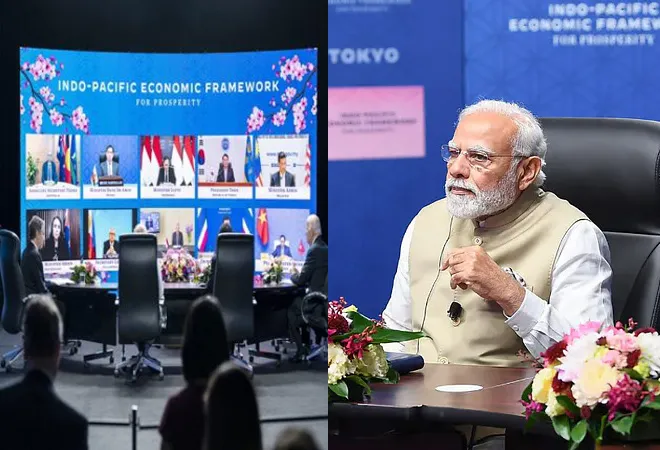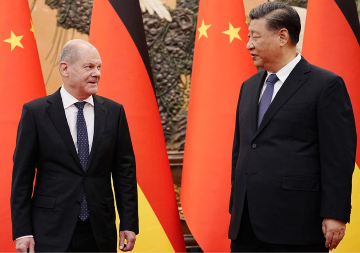
The Indo-Pacific Economic Framework (IPEF), adopted by 14 countries including India, will have its first in-person trade ministers meeting in the first week of
September 2022. The meeting will likely lay the first contours of an agreement as formal negotiations take place. The framework lays great emphasis on the harmonisation of digital trade and standards. Of the four pillars, the
‘connected economy’ pillar, widely viewed as the trade pillar, heavily references the digital economy, AI, and e-commerce. While non-binding in terms of market access and tariff reduction, it could greatly influence cooperation on and reduction of non-tariff barriers in the digital trade space. However, India’s fierce protectionist policies may not work on this platform.
Services trade vs trade policy
In recent times, there has been a race to regulate the digital space. From consumer protection to data localisation, all sorts of economic, strategic, and political questions have gotten tangled up, making digital governance a permanent minefield for policymakers. The age-old tension of balancing public good and welfare without hampering innovation and economic growth is all the more fraught due to the sheer pervasiveness of the digital sphere in our everyday lives. India is no exception when it comes to these thorny policy questions. In a setback to privacy regulation in the country—where we are already at least a decade late—the country
withdrew the draft Data Protection Bill. While the bill had several issues, leaving a vacuum in the privacy policy space is not advisable as we look to our future engagements on the international stage.
From consumer protection to data localisation, all sorts of economic, strategic, and political questions have gotten tangled up, making digital governance a permanent minefield for policymakers.
According to
UNCTAD data, trade in services which was at about US$ 6 trillion in 2019 fell to about US$ 4.9 trillion in 2020 owing to the pandemic. India’s exports of services too
increased from US$ 200 billion in 2019 to US$ 250 billion in 2021. The pandemic had little to no impact on
Mode 1 services trade (cross-border supply) which is dependent on communication technology. While other service sectors which depend on the movement of people were negatively affected by the pandemic, Mode 1 services trade continued to be stable.
The digital sphere is a great enabler of trade in general, and not just services trade. A recent
study finds that a 1 percent increase in internet bandwidth would lead to a US$ 696.71 million in goods trade for India. The multiplier would be higher when Mode 1 services trade is accounted for as it is largely enabled by the internet. According to TISMOS data, more than 60 percent of services exports from India as of 2017 were in Mode 1. To maintain the momentum that India has on Mode 1 service supply, a
stable regulatory framework is crucial. This would ideally include considerations of cost to company, cost to consumers, cost of compliance, intellectual property rules, and preferred trade partners. India is a naysayer to the e-commerce discussions at the WTO and with good reason. However, it is also not engaging at the plurilateral level on issues of digital trade and governance which is not tenable even in the next five-year term.
Middle ground
The General Data Protection Regulation (GDPR) is often cited as an international standard of best practice. It has been in effect since 2018. The fact is that proving compliance with the GDPR is not always easy for small and medium enterprises. It does, however, create a clear adaptable model. The path of least resistance would be for India to create policies that give it GDPR equivalence. However, there are developmental and political reasons why this might not be a viable option for India. Another model could be the concentric circles model that
CSIS has recommended. It involves a core of partners agreeing on as many binding rules as possible with a periphery of countries open to discussion on various digital rules. While this is plausible in the short term, one might not recommend this for the long term given the pace of change in the digital economy.
The multiplier would be higher when Mode 1 services trade is accounted for as it is largely enabled by the internet. According to TISMOS data, more than 60 percent of services exports from India as of 2017 were in Mode 1.
The other option open to the country, if it is to effectively engage at the IPEF, is to recommend and mimic the model of the Digital Economy Partnership Agreement (DEPA). The plurilateral DEPA was signed between Chile, Singapore, and New Zealand in June 2020. It is a
first-of-its-kind (although there are bilateral equivalents) non-binding agreement which aims to facilitate digital trade, ‘enable’ trusted data flows and build trust in the digital system. South Korea and China have already requested to join this partnership, alongside Canada. It creates further urgency for India to be part of some digital agreements. India needs to bite the bullet on regulating digital trade one way or the other. It is losing out on opportunities to grow and connect its digital value chains.
No preferential agreements also mean that costs of participation in the digital economy go up in comparison to those countries which have already moved on to building preferential trade networks. The uncertainty in Indian policy does more damage to its FDI prospects than declared policy, whether protectionist or liberal.
The views expressed above belong to the author(s). ORF research and analyses now available on Telegram! Click here to access our curated content — blogs, longforms and interviews.



 The Indo-Pacific Economic Framework (IPEF), adopted by 14 countries including India, will have its first in-person trade ministers meeting in the first week of
The Indo-Pacific Economic Framework (IPEF), adopted by 14 countries including India, will have its first in-person trade ministers meeting in the first week of PREV
PREV


